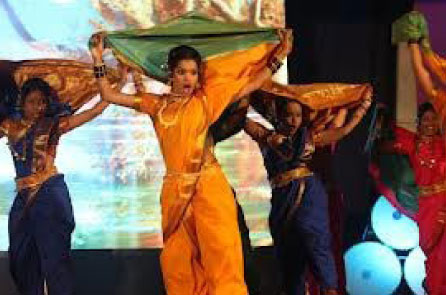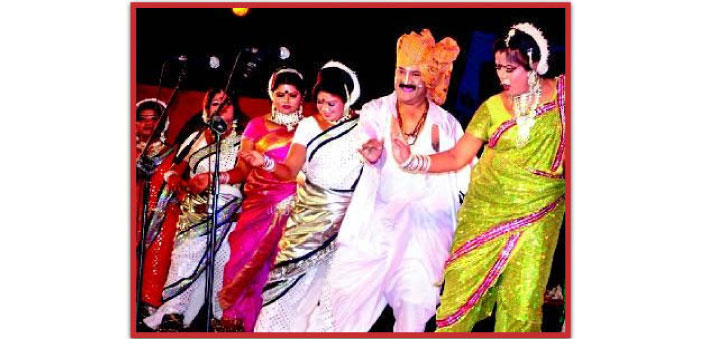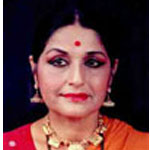AOnce the night falls, the atmosphere of rural Maharashtra throbs to the beat of the dholki (percussion instrument), ghunghroos (ankle bells), tuntune (a string instrument), halgi (a large daff) and manjeeraa (little cymbals). Soon is heard the singing – the main singer accompanied by another singer called surtyaa (the provider of the sur or drone, whose singing is in a higher pitch than the main singer. A spirited playing of the entire orchestra announces the coming forth of a performance called ‘Tamasha’ in Marathi.
Origin of Tamasha
Tamasha is actually a theatrical form whose origin and development are traced to the towering personality of Ram Joshi (1762 A.D. to 1812 A.D.) His literary prowess was equal in Sanskrit and Marathi. His association with the gigantic personality of Moropanta, whose name is outstanding in contemporary Marathi writing, resulted in a new metrical type of singing today popularly called Lavani. Ram Joshi endeavoured to channelise this singing for moral purposes.
Some historians have traced this style of singing to the Gondhal in which a form of religious discourse is conducted, and the Lavani which provided mass entertainment in the form of ‘question’ (savaal) and ‘answer’ (jawaab). Gondhal is associated chiefly with the ‘Shakti’ worship offered in Maharashtra to Ambaa-aai (roughly translated as Ambaa-mata). The Lavani on the other hand, though following the question-answer format, is romantic and mundane in character.
The Tamasha is performed purely as an earthy dance drama, which many a times degenerated to a vulgar level, and thus was looked down upon by the educated and sophisticated strata of the Maharashtrian society.
The performance
The performance of Tamasha can be held anywhere in the village square or the courtyard of a house or even in an open field or the modern stage. Once the entire orchestra together with the singers enters the stage and renders an invocation to Ganapati – the favourite deity of Maharashtra, the entire group moves forward and backwards with their back to the audience.
The principal singer who acts as the Suthradhar sings the invocation which is called gaana and is then joined by another important character called the songadya (the Vidushaka or jester). The gaana is followed by the gavalana or gavalanee. Here the devotional mood is almost dispensed with and is replaced by an atmosphere of mundane love, teasing and titillation. The gavalana is not a male actor in female garb, but is actually a woman who starts a dialogue with the Suthradhar.
The entry of this woman actor-cum-dancer is what sends a thrill of anticipation in the spectators. The main female artiste enters the stage with her back to the audience, both her hands stretched above her head, holding the pallu of her sari. This increases the eagerness of the audience, which is predominantly male, to see the face of the dancer. She is followed all over the stage by the musicians. The female dance’s refrain aaika ho!aikaa (listen, all of you) has made Lavani presentation very popular all over Maharashtra state.

The risqué element
Today the entry of the female character/characters itself is highly titillating. The entry with their back to the audience, with their bodies draped very tightly in the nine yards (nav-vaaree) saris, their entire demeanour is risqué, rather than philosophical. Now the actual play begins. The principal singer lays bare the foibles of the central character and is supported by the other actors by singing the refrain jee-jee. The male characters adopt certain stylised walk on the stage; it is the woman who is the chief exponent of dancing. Their dancing reminds one of Kathak since they wear layers of ghungroos on their ankles like the Kathak dancers, but their foot work is different. They also perform intricate rhythmic patterns, but there are hardly any chakkars (spins or whirling movements). There is no discernible system of hastas (hand gestures) which can interpret words into a definitely etched vocabulary.
The musical system is a blend of classical Hindustani raagas and many folk and indigenous melodies. All this rich fare of rituals, farce, sarcasm, dance and music concludes with an aarti’ – something which is the core of the Maharashtrian system. The costumes are representative of those designated for different castes. The most eye-catching part of the costume is the pheta (turban) that each type of musician or character sports. The women are dressed in the traditional nav-vaaree saris.
In the mid-1800s there occurred a sort of revolution in the method of performing the Tamasha, ushered by Vishnu Bhave and his talented successor Annasaheb Kirloskar – both of whom changed the presentation qualitatively and also made music an integral part of the performance, which started displaying a certain level of sophistication.This most welcome change has resulted in the sangeet–naataka – so very dear to Maharashtrians, resulting in a very distinct genre of music, which is today called ‘Naatya Sangeet’.


